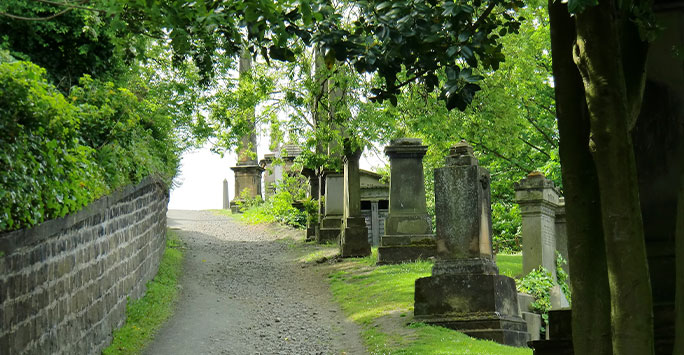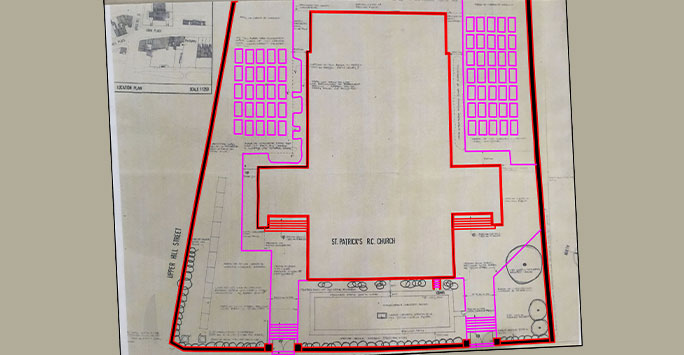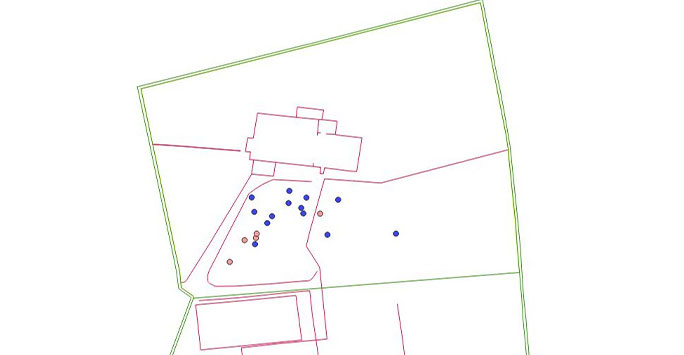
Postgraduate students Eloise Burwood and Naomi Dark report on their Graduate Internship Scheme placements
We both finished our undergraduate degrees in the ACE department, and are continuing to study Archaeology at the University of Liverpool. The Graduate Research Internship Scheme (GRIS) has given us an amazing insight into the processes of archaeology projects, and really highlighted how important our work can be for local communities. Over the course of a month, we have visited St Patrick’s Catholic Church, Broadgreen Jewish Cemetery, Toxteth Park Cemetery, and done computer-based work at the university using information from Kirkdale, North Yorkshire, working with Professor Harold Mytum, Dr Rob Philpott and research student Anna Fairley.
Learning to produce digital drawings
St Patrick’s drawing was our first major introduction to autoCAD. This is software that allows us to digitise old plans, such as an architect's drawing of St Patrick’s Church, or create new ones that are to scale. It is such a useful programme to be familiar with as it has a variety of potential applications - as we will show further in this blog. So, our first attempt was to take an image of said architects drawing, and create a digital version laid over the top of it. We had time to mess about with the system, discover the horror of attempting to hatch (fill in) a shape and finding some microscopic gap in the lines that leads to a fully covered screen, but learn how good it feels when it finally goes right. When we finally removed the original image from our new digital version, we were almost shocked to see such a professional looking copy!

After this, Naomi was tasked with something even more technical, digitising a drawing of Kirkdale, North Yorkshire, for publication by Harold Mytum about the churchyard and its monuments in the Kirkdale Monograph series. Using an old plan, an outline of the graveyard was constructed and the positions of the graves were plotted and given a point and coordinates. In order to make sure the outline was correctly scaled, we used Magic Maps, a powerful tool that enables you to measure and obtain a set of coordinates from anywhere in order to compare these with our drawings. An Excel spreadsheet was used to compile data from the graveyard including the dates of each memorial and the coordinates of each grave which we identified using AutoCad.

Cad plot of 18th-century Kirkdale memorials
The spreadsheet and AutoCad drawing of Kirkdale were initially used together in a programme called ArcGIS. However, we ultimately decided to use a different software - QGIS - due to technical difficulties. Using QGIS we were able to sort the graves by the date of the memorial which allowed us to display different sets of graves depending on their age (here the 18th-century memorials are plotted). This demonstrates how powerful QGIS is as a tool for manipulating data as it allows us to identify trends that we cannot see without separating the graves by their date. QGIS allows us to take apart the data visually to help us identify trends therein.
St Patrick’s surveys
The crypt has been surveyed for the first time by the project, where possible using a Total Station Theodolite (TST), but some parts of the crypt were inaccessible using that technique. We had the fun of mapping out the back of the crypt at St Patrick’s, up on a sandstone ledge, with us trying to reach every tiny corner so we could shout back measurements to Rob for his drawing. It was almost comical to see us trying to balance on rubble in a space half the size of us, holding the tape measures up across various features on the ledge. We discovered pretty quickly that what we originally thought was the back wall was in fact a series of pillars, leading us even further into the depths of the crypt for yet more measurements.